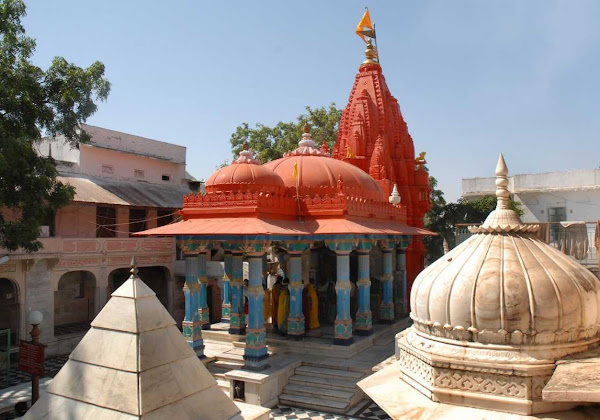Pushkar Brahma Temple- Rajasthan

Address
Pushkar Brahma Temple- Pushkar, Ajmer district, Rajasthan-305022.
Deity
Brahma Amman: Gayathri
Introduction
- Location: Pushkar, Rajasthan, India.
- Significance: One of the very few existing temples dedicated to the Hindu creator-god Brahma.
- Construction: Dates back to the 14th century; later partly rebuilt.
- Architecture: Made of marble and stone slabs with a distinct red pinnacle (shikhara) and a hamsa (swan) bird motif.
- Deity: The sanctum sanctorum houses a four-headed Brahma and his consort Gayatri (goddess of Vedas).
- Governance: Managed by the Sanyasi (ascetic) sect priesthood.
Puranic Significance:
- Legend:
- Creation of Lakes: Brahma, while slaying the demon Vajranabha, caused lotus petals to fall at three places, creating the Pushkar Lake (Jyeshta Pushkar), Madya Pushkar, and Kanishta Pushkar.
- Naming of Pushkar: The place where the flower fell was named “Pushkar” (flower hand).
- Yajna and Curse: Brahma performed a yajna at Pushkar. Due to his wife Savitri’s (Saraswati) absence, Brahma married Gayatri (a sanctified milkmaid) to complete the yajna. Savitri cursed Brahma to be worshipped only in Pushkar, along with curses to other deities and priests.
- Redemption: Gayatri’s intervention diluted the curses, blessing Pushkar as the king of pilgrimages, and ensuring other divine fates were improved. Savitri became a spring (Savitri Jharna) in the Ratnagiri hill.
Beliefs:
- Sacredness: Pushkar Lake is considered a holy theertham (sacred pilgrimage site). Settling near and giving Dharmapana (charitable offerings) is believed to bring positive change to one’s fate.
- Temple Visit: Visiting the Brahma temple is considered to be auspicious and capable of altering one’s destiny.
Special Features:
- Architecture:
- Plinth: The temple is set on a high platform, accessible by marble steps leading to a decorated entrance archway.
- Sanctum Sanctorum: Features a red shikara (spire) approximately 70 feet (21 m) high with a hamsa motif.
- Materials: Built with stone slabs and blocks joined with molten lead; interiors have a marble floor (black and white checks) and walls inlaid with silver coins donated by devotees.
- Silver Turtle: Located in the mandap, facing the Garbhagriha (sanctum sanctorum).
Festivals:
- Kartik Poornima: Major festival dedicated to Brahma, attracting large numbers of pilgrims who bathe in the sacred Pushkar Lake before visiting the temple.
Century/Period/Age
14th century
Managed By
Archaeological Survey of India (ASI)
Nearest Bus Station
Pushkar
Nearest Railway Station
Ajmer Station
Nearest Airport
Jaipur









